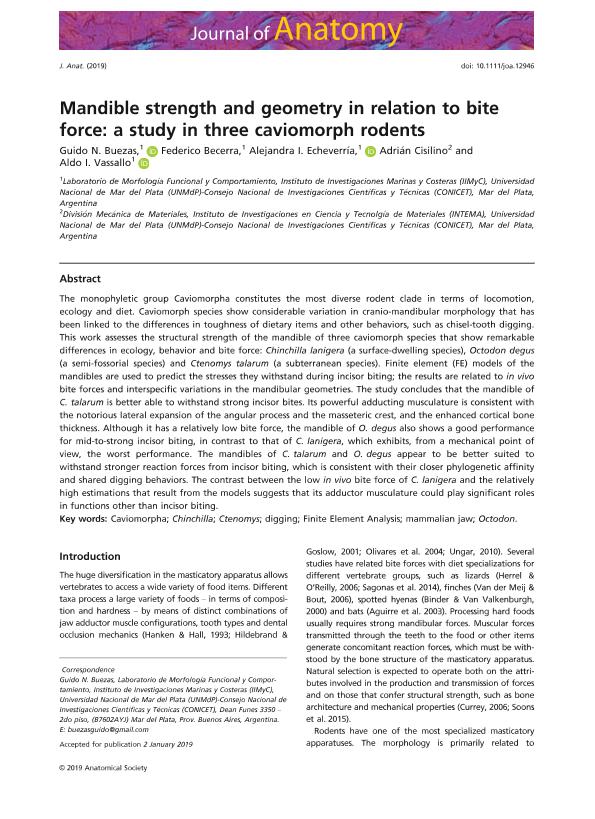Mostrar el registro sencillo del ítem
dc.contributor.author
Buezas, Guido Nicolás

dc.contributor.author
Becerra, Federico

dc.contributor.author
Echeverría, Alejandra Isabel

dc.contributor.author
Cisilino, Adrián
dc.contributor.author
Vassallo, Aldo Iván

dc.date.available
2021-01-05T18:05:32Z
dc.date.issued
2019-02
dc.identifier.citation
Buezas, Guido Nicolás; Becerra, Federico; Echeverría, Alejandra Isabel; Cisilino, Adrián; Vassallo, Aldo Iván; Mandible strength and geometry in relation to bite force: a study in three caviomorph rodents; Wiley Blackwell Publishing, Inc; Journal of Anatomy; 234; 4; 2-2019; 564-575
dc.identifier.issn
0021-8782
dc.identifier.uri
http://hdl.handle.net/11336/121511
dc.description.abstract
The monophyletic group Caviomorpha constitutes the most diverse rodent clade in terms of locomotion, ecology and diet. Caviomorph species show considerable variation in cranio-mandibular morphology that has been linked to the differences in toughness of dietary items and other behaviors, such as chisel-tooth digging. This work assesses the structural strength of the mandible of three caviomorph species that show remarkable differences in ecology, behavior and bite force: Chinchilla lanigera (a surface-dwelling species), Octodon degus (a semi-fossorial species) and Ctenomys talarum (a subterranean species). Finite element (FE) models of the mandibles are used to predict the stresses they withstand during incisor biting; the results are related to in vivo bite forces and interspecific variations in the mandibular geometries. The study concludes that the mandible of C. talarum is better able to withstand strong incisor bites. Its powerful adducting musculature is consistent with the notorious lateral expansion of the angular process and the masseteric crest, and the enhanced cortical bone thickness. Although it has a relatively low bite force, the mandible of O. degus also shows a good performance for mid-to-strong incisor biting, in contrast to that of C. lanigera, which exhibits, from a mechanical point of view, the worst performance. The mandibles of C. talarum and O. degus appear to be better suited to withstand stronger reaction forces from incisor biting, which is consistent with their closer phylogenetic affinity and shared digging behaviors. The contrast between the low in vivo bite force of C. lanigera and the relatively high estimations that result from the models suggests that its adductor musculature could play significant roles in functions other than incisor biting.
dc.format
application/pdf
dc.language.iso
eng
dc.publisher
Wiley Blackwell Publishing, Inc

dc.rights
info:eu-repo/semantics/openAccess
dc.rights.uri
https://creativecommons.org/licenses/by-nc-sa/2.5/ar/
dc.subject
CAVIOMORPHA
dc.subject
CHINCHILLA
dc.subject
CTENOMYS
dc.subject
DIGGING
dc.subject
FINITE ELEMENT ANALYSIS
dc.subject
MAMMALIAN JAW
dc.subject
OCTODON
dc.subject.classification
Biofísica

dc.subject.classification
Ciencias Biológicas

dc.subject.classification
CIENCIAS NATURALES Y EXACTAS

dc.title
Mandible strength and geometry in relation to bite force: a study in three caviomorph rodents
dc.type
info:eu-repo/semantics/article
dc.type
info:ar-repo/semantics/artículo
dc.type
info:eu-repo/semantics/publishedVersion
dc.date.updated
2020-11-16T20:04:59Z
dc.journal.volume
234
dc.journal.number
4
dc.journal.pagination
564-575
dc.journal.pais
Reino Unido

dc.description.fil
Fil: Buezas, Guido Nicolás. Consejo Nacional de Investigaciones Científicas y Técnicas. Centro Científico Tecnológico Conicet - Mar del Plata. Instituto de Investigaciones Marinas y Costeras. Universidad Nacional de Mar del Plata. Facultad de Ciencias Exactas y Naturales. Instituto de Investigaciones Marinas y Costeras; Argentina
dc.description.fil
Fil: Becerra, Federico. Universidad Nacional de Mar del Plata; Argentina. Consejo Nacional de Investigaciones Científicas y Técnicas. Centro Científico Tecnológico Conicet - Mar del Plata. Instituto de Investigaciones Marinas y Costeras. Universidad Nacional de Mar del Plata. Facultad de Ciencias Exactas y Naturales. Instituto de Investigaciones Marinas y Costeras; Argentina
dc.description.fil
Fil: Echeverría, Alejandra Isabel. Universidad Nacional de Mar del Plata; Argentina. Consejo Nacional de Investigaciones Científicas y Técnicas. Centro Científico Tecnológico Conicet - Mar del Plata. Instituto de Investigaciones Marinas y Costeras. Universidad Nacional de Mar del Plata. Facultad de Ciencias Exactas y Naturales. Instituto de Investigaciones Marinas y Costeras; Argentina
dc.description.fil
Fil: Cisilino, Adrián. Consejo Nacional de Investigaciones Científicas y Técnicas. Centro Científico Tecnológico Conicet - Mar del Plata. Instituto de Investigaciones en Ciencia y Tecnología de Materiales. Universidad Nacional de Mar del Plata. Facultad de Ingeniería. Instituto de Investigaciones en Ciencia y Tecnología de Materiales; Argentina
dc.description.fil
Fil: Vassallo, Aldo Iván. Universidad Nacional de Mar del Plata; Argentina. Consejo Nacional de Investigaciones Científicas y Técnicas. Centro Científico Tecnológico Conicet - Mar del Plata. Instituto de Investigaciones Marinas y Costeras. Universidad Nacional de Mar del Plata. Facultad de Ciencias Exactas y Naturales. Instituto de Investigaciones Marinas y Costeras; Argentina
dc.journal.title
Journal of Anatomy

dc.relation.alternativeid
info:eu-repo/semantics/altIdentifier/url/https://onlinelibrary.wiley.com/doi/abs/10.1111/joa.12946
dc.relation.alternativeid
info:eu-repo/semantics/altIdentifier/doi/https://doi.org/10.1111/joa.12946
Archivos asociados
